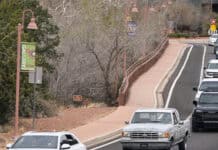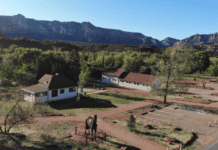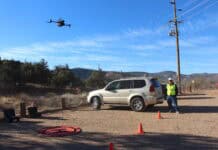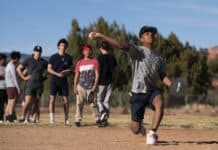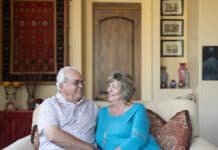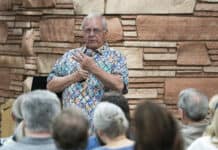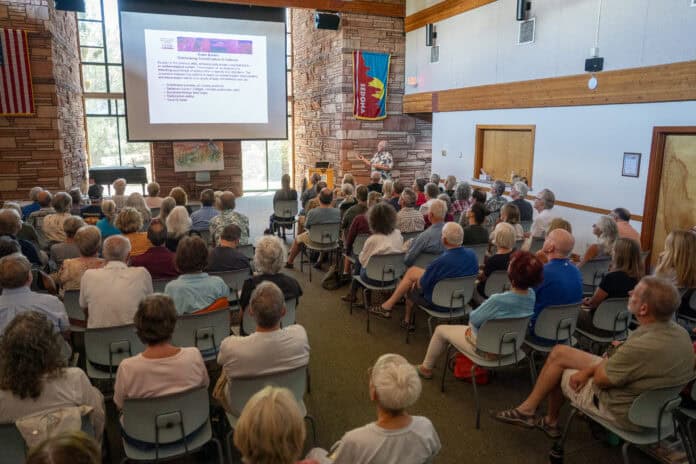
Ken Zoll, executive director emeritus of the Verde Valley Archaeology Center and Museum, gave a presentation on the archaeological history of the Middle Verde Valley at the Sedona Public Library on Aug. 17. Zoll commented it was likely to be the last time he would give that particular talk, which is based on one he created for Northern Arizona University’s Road Scholars program, as NAU is adjusting its programming.
“I want to start moving on to other things,” Zoll said. “I used to paint [in] Chicago, so I want to get back into painting and I picked up my trumpet again for my own personal enjoyment. I’m getting up there in age and it’s time to just do what I like to do and spend more time on my life.”
Zoll typically paints bright landscapes in oil and recently rediscovered his love of playing jazz after ditching his first love for his true love.
“I played in a band during college and then I sold my trumpet to buy my wife’s wedding ring,” Zoll said. He and his wife Nancy will celebrate their 54th anniversary in a few weeks. In the meantime, a friend of Zoll’s who recently retired found a trumpet he wasn’t playing in a closet and passed it along to him.
“He just handed it to me, and that’s what started me up again,” Zoll said. “I’m having fun with it … It’s freeing and it’s expressive, and so just enjoying playing and learning again.”
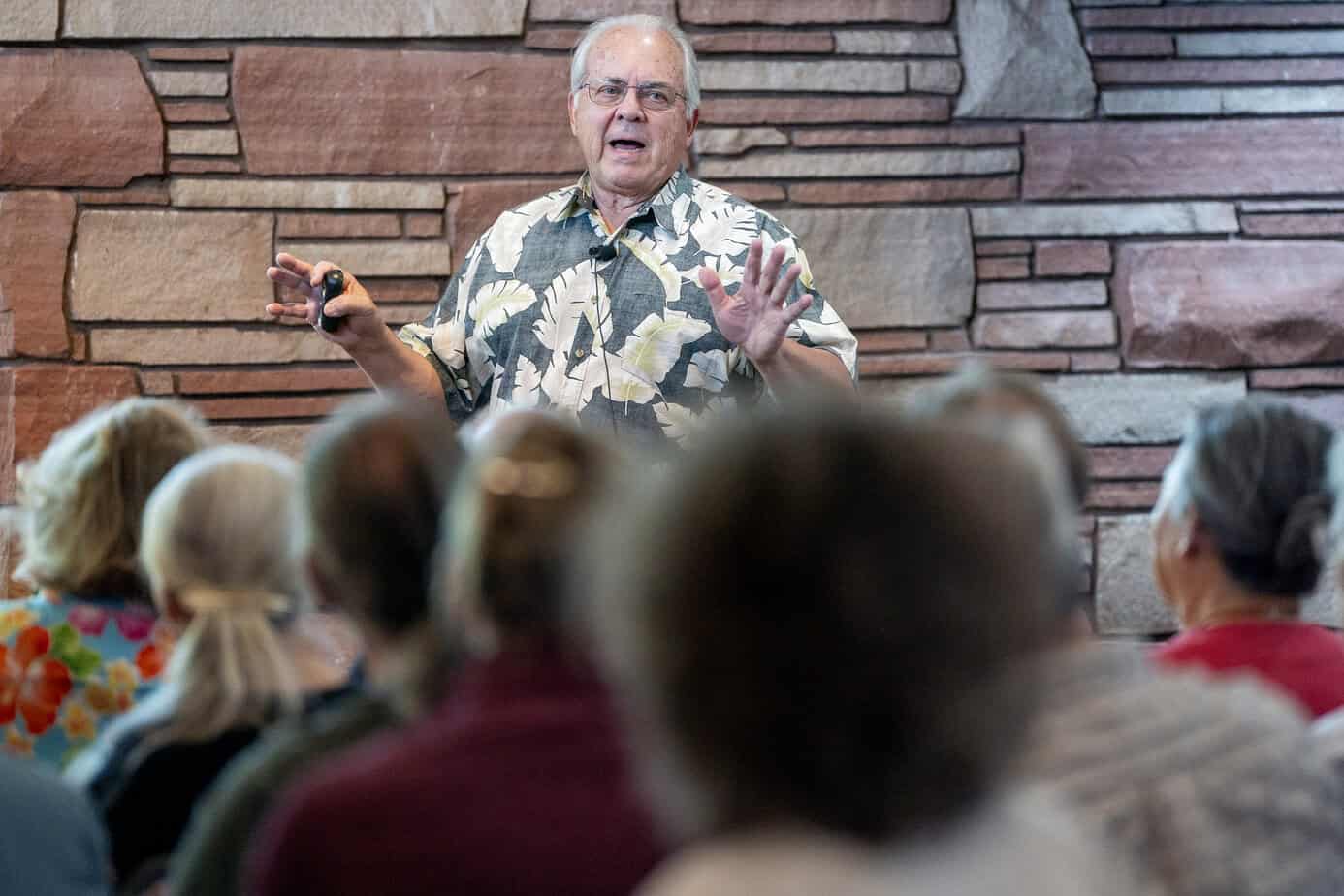
David Jolkovski/Larson Newspapers
During his presentation, Zoll addressed the work of Dr. Edgar A. Mearns, the first archaeologist to study the Verde Valley, who was a military surgeon and naturalist who came to Fort Verde from 1884 to 1888 for the birding.
“[Mearns] was the first to visit Montezuma Castle and Well, and he would create little rack cards, they’re just index card sizes, and it would say where it was, what type of place it was … and one or two sentences to describe it … He was the first to record an awful lot of these [sites] and he put it all together in a book, ‘Ancient Dwellings of the Rio Verde Valley,’ published in 1890,” Zoll said.
The National Park Service’s 1958 handbook for the Montezuma Castle site by Albert H. Schoreder and Homer F. Hastings stated that historical graffiti at the location indicates the presence of at least one European-American at the site by 1880.
“Upon my first visit in 1884, it was evident that nothing more than a superficial examination had ever been made,” Mearns wrote in Popular Science Monthly in 1890. “In 1886, I caused the debris on the floors to be shoveled over. This material consisted of a quantity of dust and broken fragments of pottery and stone implements, together with the accumulation of guano from bats that inhabited the building. This accumulation, in the largest room of the top floor, was four feet in depth. As no one had ever disturbed it, the floor was found in exactly the same condition in which it was left by the latest occupants.”
“[Cosmos Mindeleff] is a good example of how the interest created by Mearns influenced him to come up and take a look,” Zoll said. “Being a surveyor by trade with the Bureau of Ethnology, he was the first to record cavates.”
“Cavate lodges comprise a type of structures closely related to cliff houses and cave dwellings,” Mindeleff wrote in his 1896 work “Aboriginal Remains in the Verde Valley.” “The term is a comparatively new one, and the structures themselves are not widely known. They differ from the cliff houses and cave dwellings principally in the fact that the rooms are hollowed out of cliffs and hills by human agency.”
Mindeleff first arrived in the Arizona Territory in 1890 to work on stabilizing the Great House at what is now Casa Grande Ruins National Monument.
“He has some free time, and he’s heard about what was going on the Verde River,” Zoll said.
Later, Mindeleff became the first to document scientifically the eponymous Mindeleff Cavate Lodge Group. The site consists of 98 cavates with 367 rooms and is located near the Beasley Flat Day Use Area at the end of Beasley Flat Road about 11½ miles south of Camp Verde.
“What you find is [with] Cosmos Mindeleff, his wife [Emma] was the one carrying all the equipment,” Zoll said, citing the work of Dr. Nancy J. Parezo at the University of Arizona. “It turns out their wives were the ones that were carrying the material, doing the drawings, doing the handwriting. They were doing the real work, and [Cosmos] was out having fun … The women that were with these archaeologists probably did more archaeological work than the guys.”
In 1895, the Smithsonian Institute invited Jesse Walter Fewkes to conduct an archaeological expedition to the Arizona Territory. Fewkes issued a report on his findings in 1898 and published a second report covering numerous archaeological sites from Oak Creek Canyon to Prescott in 1912.
“Honanki and its sister site, Palatki, were the largest cliff dwellings of the red rock country between AD 1150 and 1350,” the U.S. Forest Service’s website states. “The Sinagua, ancestors of the Hopi, lived here … They were first described by Fewkes … who gave them the Hopi names of Honanki [Badger House] and Palatki [Red House]. The Hopi, however, have no specific names for these sites.”
The Sinagua departed the Verde Valley around 1450 CE. Some Hopi clans claim descent from the Sinagua, but the Pima, Tohono O’odham, Yavapai and Zuni peoples potentially also have cultural, linguistic and historical connections to the Sinagua and it is not clear where they may have migrated.
“Then [Fewkes] visited the Crane Petroglyph Site. It wasn’t even the V Bar V Ranch back then,” Zoll said, adding that Fewkes simply described the site that was formally renamed in March as “inscriptions on a sandstone wall.” “So a lot of the material we know about the area is based on Dr. Fewkes.”
Zoll said he will continue to do educational programming at the Crane Petroglyph Heritage Site in the future and will take requests to do talks on archaeology but will no longer be seeking out those opportunities.



